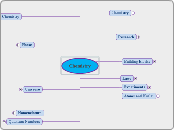Chemistry
Chemistry
study of composition
Structures and properties
of matter and the changes it undergoes
Branches of Chemistry
Inorganic
involves non carbon based compounds
Organic
involves carbon based compounds
Biochemistry
compounds and reactions in living things
Analytical
composition (qualitative, quantitative) used in enviromental chemistry
Physical
properties, relation, between Energy and Matter spectra
Theoretical
uses math and computers to design molecules/predict properties
Research
Basic
just for knowing
Applied
used to try solving problems
Matter
anything that has mass and volume
Mass
a measure of the amount of matter(g)
Weight
a measure of attraction of gravity for matter N or lb.
Phase
a region of matterwith
a) the same chemical composition and same physical state
b) the same chemical and physical properties
there are boundaries between phases
a homogeneous mix has 1 phase
a heterogeneous mix has more than 1
Building Blocks
Atom
smallest unit
retains properties of element
Molecule
2 or more atoms
covalentsly bonded
Properties
Exetensive
property that depends on the amount of matter
Intensive
property that doesn't depend on amount of matter
Physical
A propery that can be determined with out changing chemical identity of the substance
Chemical
Property that can be determined with and actural or potential change in chemical identity of substance
or property that indicates how a substance does/doesn't react
Characteristic
a property that can keep determines the chemical identity of a substance
Universe
Matter
Pure Substance(No)
Compound(Yes)
2 or more kinds of atoms chemically bonded
Method of Seperation
seperated by chimcal means
Composition
Fixed ratios of componets
Properties comared to properites of componets
Properties of componenets usually different from properties of components
Element(No)
one kind of atom
Mixture(Yes)
Homogeneous(Yes)=solution
Method of Seperation
Sperated by physical means
Compostion
ratio of components can vary
Properties compared to properties of components
Properties of mixtures are a blen of the properites of the components
Hetergeneos(No)
Energy
Potential
Stored energy due to position, composition, or condition(joules)
PE = mgh
Kinetic
energy of motion
KE = 1/2mv^2
Law of Conservation of Energy
E= frequency x Planck's Constant
Low energy, low frequency, long wavelength
high frequency, high wavelength, short wavelength
Laws
Law of Conservation of Mass
Mass can neither be destroyed nor created
Exceptions nuclear reactions
Law of Definite Proportion
A chemical compound contains the same element
in same proportions no matter the size or the source of the sample
Law of Multiple Proportions
If two or more compounds are formed by the same two elements
Than the masses form small whole number ratios
Hydrogen Isotopes
Protium
Deuterium
Tritium
Dalton's Atomic Theory
Accepted
Everything is made of tiny atoms called atoms
Atoms can combine in small whole number ratios to make compounds
In chemical reactions atoms are either rearranged, combined, or seperated
Modified
Atoms smallest building blocks, could not be created, destroyed, or broken down
Atoms of the same element have the same mass, size, and other properties
Experiments
Cathode ray Tube Experiment
had a tube full of gas and pass through a ray of light and found
electrons (The paddle wheel being pushed pushed by electrons)
Rutherford's Experiment
Shot postively charged alpha particles at a piece of gold foil
Found Nucleus because particles bounced back
Subatomic Particle
Relative Mass
electrons 1/1837
neutrons 1
protons 1
Relative Charge
electrons -1
neutrons no charge
protons +1
Photoelectric Effect
Planch assumed energy was quantized in only certain amounts
sort of like how fans only have H, Med, and Low settings
Planch shone light at metal, and electrons were released.
Needed a minumum of energy
Assumed photons, and that light was quantized
Bohr's Atomic Model
Bohr assumed electrons were quantized, and that they only went to certain energy levels
Excited state: higher energy than the ground state
Groud State: lowest energy state of an atom
Atoms and Nuclei
pea in footballfield
1 x 10-5 of an atom (compared to atom)
Atomic number
number of protons
Mass number
number of protons and neutrons
Isotopes
Another form of the naturally occuring element.
Isotopes have same number of protons and electrons
But more or less neutrons
Notations
name of element then hyphin then mass number
Isotope Notation
Mass number
atomic number
element symbol
Meaning of Relative Atomic mass
when use the normal size number when expressing really small numbers
amu = 1/12 carbon atom mass
Nomenclature
Does it have a H with an (aq) at the end of the formula?
Yes: Name it as an acid
Does the compound have an O in it?
Yes: Name it as an Oxyacid
Name it as a Binary acid
Subtopic
No: Name it as a non-acid
Is the first element a nonmetal other than hydrogen?
Yes: Name it as a compound of two nonmetals
No: Name it as an ionic Compound
Does the first metal have a fixed oxidation state?
Yes: Name it as a Metal Compound with a fixed oxidation state
No: Name it as an ionic compound with a metal with variable oxidation state
Quantum Numbers
These help specify the properties of the atomis orbitals and the properties of electrons in orbitals
The Principal Quantum Number
n=Energy
n= 0 .... Infinity
Can be determined by the period an element is in
Orbital Q #, Angular Momentum Q #
l= shape/type of orbital
there are several orbital types
s orbital
s has a quantum number of l=0
There is only one s sublevel, which can hold 2 electrons
Has a spherical shape
p orbital
p has a quantum number of l=1
It has three sublevel for a total of 6 electrons
Has a dumbell shape
d orbital
has a quantum number of l=2
There are a total of 5 possible sublevels, with a total of 10 electrons
Has a four-leaf clover shape
f orbital
has a quantum number of l=3
Looks somewhat like two four-leaf clovers stuck together
l= 0..n-1
Magnetic Quantum Number
m= 0... + or minus l
Determines the orrientation of the orbital in space
Spin Quantum Numer
ms =spin of the electron
the valve of m (sub s) is equal to plus or minus 1/2
